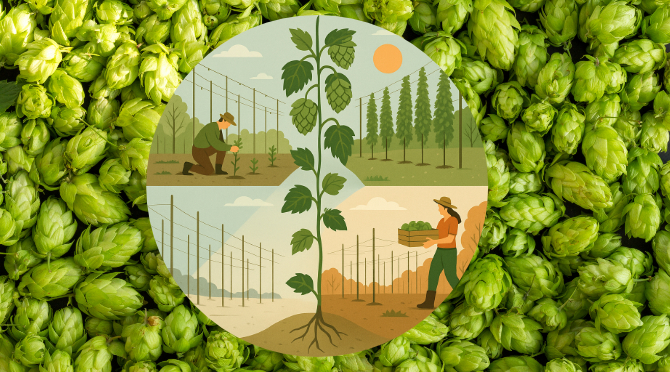
We want to walk through the year together with the hop growers - step by step, root by root. And we want to tell stories about the “green gold”.
Springtime is hop time
For the hop farmers, the most labor-intensive phase of the year has long since begun. What has emerged from the ground in recent weeks needs to be brought on track as quickly as possible - with a lot of manual work, know-how and a good deal of patience.
On our knees for the right shoot
In spring, the hops literally shoot upwards. The plant can grow up to 30 centimeters per day. Around 40 shoots emerge from each rootstock, but only two to three of them make it to the wire, where they later bear the coveted cones. And with that, the first major work peak of the year is reached: the so-called bine training.
Only the strongest, best shoots are allowed to go up - they are wound clockwise around the wires by hand. The remaining shoots are pruned out. Working in a bent or kneeling position is strenuous and puts strain on the back and joints. Machines can do the rough plucking, but the precise guidance and repeated redirection remains manual work. Because the wind doesn't make it easy: it repeatedly loosens the young shoots from the wire - so constant checking and readjustment is necessary until the end of June.
Spring cultivatioin - ground work with sensitivity
Once the hops are on the wire, the next step follows: hilling. This involves heaping up soil around the vine. This gives the plants support, retains moisture and stimulates the formation of summer roots. At the same time, loosening improves the soil structure - provided it is done moderately. The old rule applies: as much as necessary, as little as possible.
Control is better
The condition of the hop plants is constantly monitored in parallel with care. Pest pressure, the presence of beneficial insects and weather developments must be constantly monitored. Specialist knowledge and experience are crucial here, as there are often only a few days between a slight infestation and a serious threat - and the appropriate measures need to be carefully considered.
Between muscle work and millimeter work
One hectare of hops requires up to 200 working hours per year - many times more than is required for traditional crops such as cereals. The spring work forms the foundation: only those who work cleanly now can hope for a good harvest in late summer.
In hop growing, the motto is therefore not only “back to nature”, but above all: back to manual labor. Because it takes a lot of real craftsmanship before the beer ends up in the glass - and a spring that has nothing to do with relaxation.
A year with hops - and the people behind them
We'll reveal what's next for hops in the next few articles. And we'll also be happy to answer any specific questions you may have about hops, the green gold.
👉 Which hop-related topics should we explore in more depth over the next few weeks?
👉 Are there any other beer-related areas that interest you?
Author: Birgit Rieber
Photo: wegro communications with friendly AI support
Source: Association of German Hop Growers



